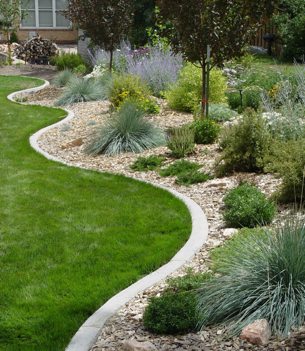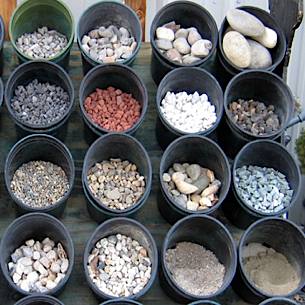Mulch Types

Mulch Types for your Landscape Beds
The Purpose of Mulch
Dispersing a bed of mulch over exposed soil areas of your garden and landscape bed areas can save you a enormous amount of time and energy.
- Mulch helps conserve a lot of water by holding the moisture in the soil and preventing evaporation.
- Secondly, mulch is one of the most effective weed preventative measures you can obtain.
- Lastly, mulch gives your landscape borders a professional manicured appearance and can enhance plantings much more than bare soil can.
Using Shredded Bark as Landscape Mulch:
One of the most popular and least expensive options for organic mulch is Shredded Bark. Although not the only source of this mulch, the most commonly used source is cedar trees. Some great characteristics of Shredded Bark is that it holds together very well, and it breaks down rather promptly, so it is a common option for sloped bank applications. Since it is most often a byproduct of the lumber industry, this mulch is considered very environmentally friendly.
Mulch Types - Shredded Leaf
If you have a lot of leaves in your yard during fall cleanup? Put them to good use by using them as an over winter mulch. They decompose promptly (less than a year), and supply numerous nutrients to your plants. To minimize the matting tendency of leaf mulch, make sure you shred your leaves prior to placement.
Mulching Types - Grass Clippings
Grass clipping is another organic mulch option that is free. Be sure it is dry prior to placement and place it in thin layers to prevent rotting and odor problems. Another great feature of grass mulch is it supplies necessary nitrogen nutrients to the soil.
Mulch Types - Straw:
Straw is another outstanding way to add an organic mulch to your yard. Besides having a fantastic looking golden hue, it breaks down a bit slower than grass does. One caution you ought to be aware of though. Straw frequently has weed seeds intermixed with it, and you have to be cautious that you are not making a bigger weed problem than you are trying to prevent.
Make Your Own Compost Mulch:
Compost mulch is one of the better organic mulch options. Compost is full of soil nutrients, and being very dark it sets off your planting beds very nicely.

Mulch Types - Pine Straw
Mulch Types - Pine Straw:
Pine Needle Mulch, or more commonly called "pine straw" is a notable mulch for acid loving plants, and is another notable source for organic mulch.
This is a common option for difficult slopes as it holds its place very well, and breaks down comparatively slowly.
Blueberries, azaleas, rhododendrons, and other conifers are common planting options in this type of mulch.
Mulch Type - Pine Bark Nuggets:
The biggest complaint with Pine Bark Nuggets is that they don't stay in position very well, particularly during periods of heavy rain.
Therefore it is recommended that they not be used on sloped areas or sloping banks. They are slow to break down and are available in a variety of sizes. Bigger nuggets will take longer to break down than smaller nuggets.
Mulch Types - Wood Chips
Another free source of mulch can be wood chips. Some homeowners purchase a chipper and make there own, or you can possibly get them from a local tree trimming company. While they will provide you with an excellent weed barrier and break down rather slowly. The new chips will rob your soil of nitrogen, and add acid to your soil as well.
Mulch Types - Cocoa Hulls
Although more pricey, if you wish to have one of the richest looking mulches, take a look at Cocoa Hull Mulch. Along with the deep rich color an texture, you get the delightful chocolate fragrance, and long-lasting qualities.
However if you have pets, be aware that the Cocoa Bean Hulls may be poisonous to dogs and cats if ingested.

Mulch Types - River Rock & Gravel
Mulch Types - River Rock and Gravel
The outstanding thing about the rock materials is that once they are applied, they don't break down over time. So they will never need replacement if installed properly. Negatives include, no nutrients are added to soil, and its difficult to split perennials.
Using Shredded Rubber as Mulch
Using this recycled material as a mulch is a very eco-friendly thing to do. It prevents the destruction of trees as is the case with many other mulch types.
This is a notable, environmentally friendly alternative to other mulches as it doesn't need replacement. Also, it is heavy and stays in place, stays looking outstanding, and keeps its new color.
Also, because it does not decay or compact, you can spread it much thinner than traditional mulches. Typically reducing the thickness from 3 inches down to about 1.5 inches.
comments powered by Disqus


































































